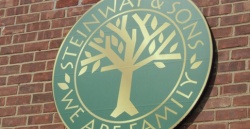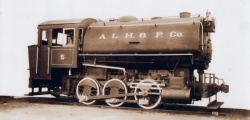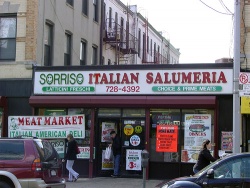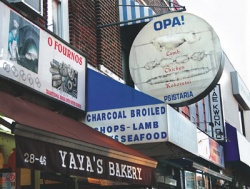Views
Immigrants in Astoria
Contents |
German Immigrants

The Germans in the 17th century were among the first to settle Astoria.[2] In the 19th century, Germans played an important role in New York’s agriculture. They developed farms and gardens in Astoria.[3] Industrialization in New York City in the late 1800s brought over immigrants and increased the demand for real estate in Astoria.[4] Many of the Germans who arrived in Astoria at this time were cabinet-makers. The Steinways, a German family who migrated to the United States in early 1850s,[5] opened the Steinway Piano Factory in Astoria in 1870. In November 1872, 10th Avenue was renamed Steinway Avenue, and it was later changed to Steinway Street. Henry Steinway built a community for his workers in Astoria,[6] known as Steinway Village,[7] which provided housing for factory workers,[8] and also included a library, a church, a kindergarten (Steinway Kindergarten,[9] one of the first free kindergartens in the United States,[10]), and a public trolley line.[11] Traditional beer gardens were scattered throughout the neighborhood, catering to the workers. In February 1889, William Steinway created the Astoria Homestead Company to buy and sell real estate in Astoria.[12] His company was instrumental in developing Steinway Village.[13]
Irish Immigrants

The Irish came to the United States to escape the economic plight and famine that the Great Famine created. The Great Famine began in 1845 and wiped out the entire potato crop, which was the staple of the Irish diet. Conditions remained the same into the 1850s. Over one million people either died of starvation, typhus, and dysentery, or left for America. The Irish population in New York City grew quickly around this time.
In the early 20th century, the Irish began moving out of Manhattan, not for better jobs or wages or in search of an ethnic community, but for a better quality of life. Astoria became the destination for many Irish immigrants for several reasons. Cheaper and better-quality apartments were being built and put on the market in Astoria. The Irish immigrants contributed to New York City’s housing development; many were renters, homeowners, superintendents, landlords, agents, salesmen, builders, and developers. The Crimmins Construction Company is an example of a company that began developing in Astoria around 1910. The construction of the Williamsburg, Manhattan, and Queensborough bridges in 1903 and 1909 meant that the East River no longer prevented movement to New York City’s other boroughs. The subway was extended to Queens in 1917, making living in Astoria more enticing because of accessibility to public transportation.
Rent increased in Manhattan after WWI, bringing more Irish to neighborhoods such as Astoria. The years between 1920 and 1930 marked the greatest movement among Irish immigrants. Another building boom occurred during 1920-1926, putting better and cheaper houses on the market. The number of New Yorkers living in Manhattan between 1910-1930 dropped from 49 to 27 percent, and Queens and the Bronx “more than doubled their percentages”. The Irish were a significant part of these movements. In some cases, residents were forced to move for “municipal improvement schemes or incentives like tax abatements.” More often, they came to live near their jobs. The Irish formed ethnic niches in the transit system, grocery chains, and live-in domestic services. Companies such as Astoria Light, Heat, and Power Company brought the Irish to Astoria.[15]
Italian Immigrants

Italians from Northern Italy came to the United States at the end of the 19th century, and Italians from Southern Italy came at the beginning of the 20th century. They left behind villages and small cities whose economic conditions were not improved by Italy’s political reunification in the 1860s. Between 1901 and 1913, 4,711,000 Italians came to the United States; 3,374,00 of them were from the south. These poor, uneducated immigrants without professional skills arrived in New York with the hope that they would find better opportunities. They came with the help of the “padrone system.” The “padrone” was a person who would help the immigrants find jobs in the labor market, and in return, he would be paid by both the immigrant and the employer. The Italians played an important role in the economy during this time because they fulfilled New York’s demand for workers, which had increased due to urbanization and industrialization. The rate of Italian immigration decreased after 1924 because the United States enforced a quota system and Fascist Italy created laws restricting emigration.[17]
Originally, the Italians in New York lived between 14th street and East Harlem, including the Mulberry District[18]. They worked as barbers, printers, mechanics, bricklayers, electricians, and carpenters. Their wages were low while the cost of living was high. They lived in crowded apartments, with seven to ten people in one bedroom[19]. By the 1920s, over half of the Italians in New York moved to other boroughs. The construction of public transportation that connected Manhattan to Astoria brought many Italians to this neighborhood. The greatest movement out of Manhattan occurred after World War I. Italian men started out with construction and factory jobs in New York,[20] but they began to switch to skilled labor and independent businesses. Laborers comprised 32.5% of the Italian population in New York in 1916; this number dropped to 10.6% in 1931. They became chauffeurs, carpenters, painters, bakers, mechanics, plasterers, clerks, salesmen, etc.[21]
The Italians’ presence in Astoria is made obvious by the prevalence of Italian delicatessens, pizza shops, bakeries, barber shops, and restaurants. Astoria has become an ethnic enclave for Italians, lessening their feelings of isolation. They have their own newspaper, Progresso, which provides information about Italian and American events. The immigrants were determined to maintain their cultural heritage; one of the ways they did this was by performing the Dance of the Giglio every summer.
Astoria has recently shown a decline in Italians; fewer Italians are coming to the United States, and many of those already living in Astoria have achieved a higher economic status and moved away. The few Italians who still come to Astoria are more educated, and many still work in construction, gardening, barber shops, machine shops, pizza shops, and restaurants.
Greek Immigrants

“Mother, I want to go to foreign lands, to foreign lands I must go”
This folk song exemplifies the economic and political troubles that Greek peasants endured at the turn of the century. Greeks began immigrating to the United States, primarily for economic opportunities. Most planned on returning to Greece once they had earned enough money to live comfortably in their hometowns, although many never returned. The immigrants were concentrated in New York and Chicago, where their population rose to 20,000 in each city in 1913. By the early 1920s, the number was 50,000. In New York, the Greeks first lived in Manhattan.[23] There, they worked in factories, as peddlers, or in the service trades.[24]
Immigration slowed in 1921 due the enactment of nationality quotas in the United States. The Reed-Johnson Act in 1924 again restricted the number of immigrants allowed into the country, and its aim was to reduce immigration from southern and eastern Europe. This Act set the Greek quota at 100 immigrants per year. From 1929 through the next three decades, the quota was 307. However, the number of Greek immigrants who came was larger because of the United States’ program of uniting immediate family members. Thus, about 2,000 Greek immigrants came between 1924 and 1930.[25]
After the Immigration Act of 1965 was passed, immigrants were no longer selected on the basis of their country of origin. This led directly to an increase in the number of Greek immigrants; from 1966 to 1971, about 15,000 Greeks came to the United States every year. Since the mid-1970s, about 9,000 Greeks came every year. These immigrants were more educated than those who arrived in the early 20th century. They worked in the food and drink business, owned pizza parlors, tailor shops, shoe repair shops, dry cleaners, and grocery and produce stores. Some worked in factories, construction, did maintenance work, or worked as waiters in Greek restaurants. The second-generation Greeks were likely to have a college education and white-collar jobs.
Greeks from the earlier wave of Greek immigration began moving to Astoria in the early 1920s after living in Manhattan for some time.[26] The immigrants in the 1960s came straight to Astoria and brought the Greek population of this neighborhood to 70,000, making Astoria the largest Greek settlement outside of Greece or Cyprus.[27] The number rose to 300,000 in the 1970s. The immigrants brought over their culture to Astoria-this “Greektown” is filled with restaurants serving Greek food, Greek grocery stores, fish stores, produce stands, and bakeries, and Greek newspapers. Even the public elementary schools teach in both Greek and English. The Hellenic American Neighborhood Action Committee was formed in 1972 to meet the need of the Greeks in Astoria.[28] The immigrants settled in Astoria partially because of the cheaper rent, but mostly because of the community it provided. As one immigrant, who came to Astoria in 1979, said, “As soon as you arrived in Astoria, you had your deli, your fish market, your butcher. You didn’t even have to speak English. The schools spoke Greek, the church people spoke Greek. You didn’t miss Greece because you had everything.”
There are not as many Greeks in Astoria today; Greek immigration has slowed and many have left the neighborhood. There are about 40,000 Greeks left in Astoria.[29] However, Greeks have left an indelible mark on Astoria that thousands of recent immigrants have been unable to erase.
Czech Immigrants
Many Czechs and Slovaks came to Astoria in the late 1800s when they migrated to the United States to escape oppression by Austria-Hungary. The Bohemian Citizens’ Benevolent Society was founded in 1892 to support Czech and Slovak families in Astoria. The organization bought two lots in 1910 and turned it into the Bohemian Hall and Beer Garden, the last outdoors beer garden in New York City.[30] (See Interesting Facts.)
Brazilian Immigrants
Brazilians began coming to the United States in large numbers in the mid-1980s, when Brazil’s economy worsened and inflation increased. According to the Brazilian government, approximately 1.4 million Brazilians left the country between 1986 and 1990. According to Maxine Margolis in Little Brazil: An Ethnography of Brazilian Immigrants in New York City, about 20,800 Brazilians arrived in the United States during this period. Many of these immigrants moved to Little Brazil in Manhattan and Astoria.[31] Those who came to New York are generally middle-class who could obtain white-collar jobs in Brazil, but they do menial labor in New York because they earn more. Today, Brazilians have moved from Little Brazil to Astoria to escape the high rents.[32] There are so many Brazilians now living in Astoria that Tatiana Pacheco, a Brazilian immigrant, feels “like [she’s] in a different town instead of 10,000 miles away.”[33]
Bosnian Immigrants
Although there have been many waves of Bosnian immigration to the United States, Bosnians first started arriving in Astoria in 1992. These immigrants came because of the political instability that ensued when Bosnia declared its independence from Yugoslavia. Most of the immigrants were Muslims who were pushed out when Serbs attempted to create a Serb-only region. Bosnians preferred living with other Bosnians, but there was no Bosnian-Muslim community already set up for these immigrants, so they moved to urban areas.[34] In 1999, a group of volunteers created the Bosnian American Association of New York City (BAA) to meet the needs of the Bosnian refugees. The headquarters are in Astoria.[35]
Other Immigrants
The groups of immigrants listed above are not the only ones to migrate to Astoria. Over the past few decades, Astoria’s racial demographics have expanded to include people from Egypt, Tunisia, Yemen, Morocco, Albania, Bangladesh,[36] India, Dominican Republic, Ecuador,[37] Croatia, Poland, Tibet, Pakistan, South Korea, Japan, and the Philippines.[38]
Return to Astoria or visit Astoria's Borders | Historic Overview | Housing in Astoria | Contemporary Profile | Interesting Facts | Explore Astoria | Testimonials of Residents | Conclusions
References
- ↑ http://nycitynewsservice.com/wp-content/plugins/yet-another-photoblog/cache/steinway_logo.69rk0c481mw44k0co4wwow0wg.27exolq5sb40wc8gkwsg0sgcg.th.jpeg
- ↑ "Astoria." Answers.com. 2009. 26 Apr 2009 <http://www.answers.com/topic/astoria-new-york>.
- ↑ Vonderlieth, Michael. "Germans In Queens: The Steinways Old Traditions In A New Key." 13 Apr 2009 <http://www.queenstribune.com/anniversary2002/germans.htm>.
- ↑ “The History of Astoria and Long Island City.” 2004. MyAstoria.com. 13 Apr 2009 <http://www.myastoria.com/history/>.
- ↑ “Steinway & Sons Piano Factory Tour.” 2006. QueensBuzz.com. 13 Apr 2009 <http://queensbuzz.com/news.php?viewStory=330>.
- ↑ Vonderlieth, Michael. "Germans In Queens: The Steinways Old Traditions In A New Key." 13 Apr 2009 <http://www.queenstribune.com/anniversary2002/germans.htm>.
- ↑ “The History of Astoria and Long Island City.” 2004. MyAstoria.com. 13 Apr 2009 <http://www.myastoria.com/history/>.
- ↑ “Steinway.” Forgotten NY Street Scenes. 13 Apr 2009 <http://www.forgotten-ny.com/STREET%20SCENES/Steinway/steinway.html>.
- ↑ Vonderlieth, Michael. "Germans In Queens: The Steinways Old Traditions In A New Key." 13 Apr 2009 <http://www.queenstribune.com/anniversary2002/germans.htm>.
- ↑ “The History of Astoria and Long Island City.” 2004. MyAstoria.com. 13 Apr 2009 <http://www.myastoria.com/history/>.
- ↑ “Steinway.” Forgotten NY Street Scenes. 13 Apr 2009 <http://www.forgotten-ny.com/STREET%20SCENES/Steinway/steinway.html>.
- ↑ Vonderlieth, Michael. "Germans In Queens: The Steinways Old Traditions In A New Key." 13 Apr 2009 <http://www.queenstribune.com/anniversary2002/germans.htm>.
- ↑ Kelsey, J. S. “History of Long Island City, New York.” Internet Archive. 13 Apr 2009 <http://www.archive.org/stream/historyoflongisl00kels/historyoflongisl00kels_djvu.txt>.
- ↑ http://members.trainweb.com/bedt/indloco/alhp.html
- ↑ Bayor, Ronald H., and Timothy J. Meagher, eds. The New York Irish. Baltimore: The Johns Hopkins University Press, 1996.
- ↑ http://z.about.com/d/queens/1/0/J/A/astoria-sorriso.jpg
- ↑ Fortuna, Giuseppe. The Italian Dream: The Italians of Queens, New York City. San Francisco: Mellen Research University Press, 1991.
- ↑ Baily, Samuel L. Immigrants in the Lands of Promise. Ithaca: Cornell University Press, 1999.
- ↑ Moquin, Wayne, and Charles Van Doren, eds. A Documentary History of the Italian Americans. New York: Praeger Publishers, 1974.
- ↑ Baily, Samuel L. Immigrants in the Lands of Promise. Ithaca: Cornell University Press, 1999.
- ↑ The Italians of New York. New York: Random House, 1969.
- ↑ http://www.cnewa.org/mag-article-bodypg-us.aspx?articleID=3298
- ↑ Moskos, Jr., Charles C. Greek Americans: Struggle and Success. Englewood Cliffs: Prentice-Hall, Inc., 1980.
- ↑ Psomiades, Harry J., and Alice Scourby, eds. The Greek American Community in Transition. New York: Pella Publishing Company, Inc., 1982.
- ↑ Moskos, Jr., Charles C. Greek Americans: Struggle and Success. Englewood Cliffs: Prentice-Hall, Inc., 1980.
- ↑ Psomiades, Harry J., and Alice Scourby, eds. The Greek American Community in Transition. New York: Pella Publishing Company, Inc., 1982.
- ↑ Moskos, Jr., Charles C. Greek Americans: Struggle and Success. Englewood Cliffs: Prentice-Hall, Inc., 1980.
- ↑ Moskos, Jr., Charles C. Greek Americans: Struggle and Success. Englewood Cliffs: Prentice-Hall, Inc., 1980.
- ↑ Gragnani, Vincent. “Opa! Discovering New York's Greek Enclave.” 2007. Catholic Near East Welfare Association. 13 Apr 2009 <http://www.cnewa.org/mag-article-bodypg-us.aspx?articleID=3298>.
- ↑ "NYC-Queens-Astoria: Bohemian Hall and Beer Garden." flickr. 17 Apr 2009 <http://www.flickr.com/photos/wallyg/469161333/in/set-72157594155730842/>.
- ↑ Jefferson, Alphine W. “Brazilian Americans.” Multicultural America. 13 Apr 2009 <http://www.everyculture.com/multi/A-Br/Brazilian-Americans.html>.
- ↑ Barteides, Ernest. “Little Brazil is Dead, Long Live Astoria.” Brazzil 17 July 2005 Web.13 Apr 2009. <http://www.brazzil.com/2005-mainmenu-79/154-july-2005/9340.html>.
- ↑ “Spotlight on Bosnian American Association of New York City.” 13 Apr 2009 <http://www.ethniccommunities.org/spotlight_Bosnian.htm>.
- ↑ Miller, Olivia. “Bosnian Americans.” Multicultural America. 13 Apr 2009 <http://www.everyculture.com/multi/A-Br/Bosnian-Americans.html>.
- ↑ “Spotlight on Bosnian American Association of New York City.” 13 Apr 2009 <http://www.ethniccommunities.org/spotlight_Bosnian.htm>.
- ↑ "Astoria, Queens." AbsoluteAstronomy.com. 26 Apr 2009 <http://www.absoluteastronomy.com/topics/Astoria,_Queens>.
- ↑ “The History of Astoria and Long Island City.” 2004. MyAstoria.com. 13 Apr 2009 <http://www.myastoria.com/history/>.
- ↑ "Astoria Queens Neighborhood." Econo Rentals. 26 Apr 2009 <http://www.econorentalsny.com/ny_info/Astoria_Queens_Neighborhood.htm>.